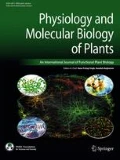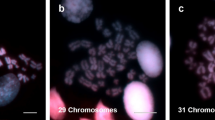Abstract
Epimedium tianmenshanensis is a rare perennial herb distributed in China, and it is also an important medicinal plant. Here, we used illumina paired-end sequencing technology to obtain the complete chloroplast genome of E. tianmenshanensis, and compared analysis with related species. The length of the complete chloroplast genome of E. tianmenshanensis is 156,956 bp, which is a relatively conserved quadripartite structure including a large single copy (LSC) region of 88,409 bp, a small single copy (SSC) region of 17,448 bp, and a pair of inverted repeat (IRa/IRb) regions of 25,550 bp. The whole genome contains 132 unique genes, including 85 protein-coding genes, 38 tRNA genes, eight rRNA genes and one pseudogene. 87 simple sequence repeats (SSRs) were identified, and most of them were found to be composed of A/T. In addition, 22,923 codons were detected in 78 protein-coding genes of E. tianmenshanensis, and the overall codon bias pattern in the genome tended to use A/U ending codons. Phylogenetic analysis demonstrated that all the Epimedium species formed a monophyletic clade, and E. tianmenshanensis had the closest relationship to E. dolichostemon. The results of this study provided useful molecular information about the evolution and molecular biology of E. tianmenshanensis.






Similar content being viewed by others
Availability of data
The DNA sequences was submitted to GenBank under the accession number MT028488.
References
An WL, Li J, Yang ZR, Huang YY, Huang S, Zheng XS (2020) Characteristics analysis of the complete Wurfbainia villosa chloroplast genome. Physiol Mol Biol Plants 26:747–758
Asaf S, Khan AL, Khan AR, Muhammad W, Kang SM, Khan MA et al (2016) Complete chloroplast genome of Nicotiana otophora and its comparison with related species. Front Plant Sci 7:843
Benson G (1999) Tandem repeats finder: a program to analyze DNA sequences. Nucleic Acids Res 27:573–580
Boynton JE, Gillham NW, Harris EH et al (1988) Chloroplast transformation in Chlamydomonas with high velocity microprojectiles. Science 240:1534–1538
Chen CH, Zheng YJ, Liu SA, Zhong YD, Wu YF, Li J et al (2017) The complete chloroplast genome of Cinnamomum camphora and its comparison with related Lauraceae species. PeerJ 5:e3820
Chinese Pharmacopoeia Editorial Committee (2020) Chinese Pharmacopoeia (part I). China Medical Science and Technology Press, Bejing
Dierckxsens N, Mardulyn P, Smits G (2016) NOVOPlasty: de novo assembly of organelle genomes from whole genome data. Nucleic Acids Res 45:1–9
Gu CH, Tembrock LR, Zheng SY, Wu ZQ (2018) The complete chloroplast genome of Catha edulis: a comparative analysis of genome features with related species. Int J Mol Sci 19:525
Guo BL, Fe SZ, Zhong GY, Xiao PG (2007) Two new species of Epimedium (Berberidaceae) from China. Acta Phytotaxon Sin 45:813–821
Hall TA (1999) BioEdit: a user-friendly biological sequence alignment program for Windows 95/98/NT. Nucleic Acids Symp Ser 41:95–98
He SZ, Wang YY, Guo BL, Xu WF (2010) Epimedium pudingense (Berberidaceae), a new species from Guizhou, China. Ann Bot Fenn 47:226–228
Jiang J, Song J, Jia XB (2015) Phytochemistry and ethnopharmacology of Epimedium L. species. CHM 7:204–222
Katoh K, Standley DM (2013) MAFFT multiple sequence alignment software version 7: improvements in performance and usability. Mol Biol Evol 30:772–780
Kawabe A, Miyashita NT (2003) Patterns of codon usage bias in three dicot and four monocot plant species. Genes Genet Syst 78:343–352
Kurtz S, Choudhuri JV, Ohlebusch E, Schleiermacher C, Stoye J, Giegerich R (2001) REPuter: the manifold applications of repeat analysis on a genomic scale. Nucleic Acids Res 29:4633–4642
Li R, Guo MY, Pang XH (2018) Identification and classification of medicinal plants in Epimedium. CHM 10:249–254
Lohse M, Drechsel O, Bock R (2007) OrganellarGenomeDRAW (OGDRAW): a tool for the easy generation of high-quality custom graphical maps of plastid and mitochondrial genomes. Curr Genet 52:267–274
Lowe TM, Chan PP (2016) tRNAscan-SE On-line: integrating search and context for analysis of transfer RNA genes. Nucleic Acids Res 44:W54–W57
Ma H, He X, Yang Y, Li M, Hao D, Jia Z (2011) The genus Epimedium: an ethnopharmacological and phytochemical review. J Ethnopharmacol 134:519–541
Martin M (2011) Cutadapt removes adapter sequences from high-throughput sequencing reads. EMBnet J 17:10–12
Meng J, Li XP, Li HT, Yang JB, Wang H, He J (2018) Comparative analysis of the complete chloroplast genomes of four Aconitum medicinal species. Molecules 23:1015–1017
Nylander JAA (2004) MRMODELTEST version 2.1. Computer program distributed by the author. Uppsala University, Uppsala
Pauwels M, Vekemans X, Godé C, Frérot H, Castric V, Saumitoulaprade P (2012) Nuclear and chloroplast DNA phylogeography reveals vicariance among European populations of the model species for the study of metal tolerance, Arabidopsis halleri (Brassicaceae). New Phytol 193:916–928
Peden JF (1999) CodonW. PhD Dissertation, University of Nottingham, Nottinghamshire, UK
Ronquist F, Teslenko M, Van DMP, Ayres DL, Darling A, Sebastian H et al (2012) Mrbayes3.2: efficient bayesian phylogenetic inference and model choice across a large model space. Syst Biol 61:539–542
Sheng MY, Tian XJ (2011) A new species of Epimedium (Berberidaceae) with 24 chromosomes from Guizhou, China. Novon 21:262–265
Sun Y, Fung KP, Leung PC, Shaw PC (2005) A phylogenetic analysis of Epimedium (Berberidaceae) based on nuclear ribosomal DNA sequences. Mol Phylogenet Evol 35:287–291
Swofford DL (2002) PAUP*: Phylogenetic Analysis using Parsimony (* and Other Methods), version 4.0b 10. Sinauer, Sunderland
Tillich M, Lehwark P, Pellizzer T, Ulbricht-Jones ES, Fischer A, Bock R et al (2017) GeSeq-versatile and accurate annotation of organelle genomes. Nucleic Acids Res 45:W6–W11
Wang WB, Yu H, Qiu XP (2018) Analysis of repeat sequence and codon bias of chloroplast genome in Scutellaria baicalensis. Mol Plant Breed 16:2445–2452
Wu XM, Wu SF, Ren DM, Zhu YP, He FC (2007) The analysis method and progress in the study of codon bias. Hereditas 29:420–426
Yang Y, Zhang Y, Chen YK, Gul JM, Zhang JW, Liu Q et al (2019) Complete chloroplast genome sequence of the mangrove species Kandelia obovata and comparative analyses with related species. PeerJ 7:e7713
Ying TS, Boufford DE, Brach AR (2011) Berberidaceae. In: Wu ZY, Raven PH (eds) Flora of China. Science Press and Missouri Botanical Garden Press, Beijing and St. Louis, pp 714–800
Yuan C, Zhong WJ, Mou FS, Gong YY, Pu DQ, Ji PC, Huang HY, Yang ZH, Zhang C (2017) The complete chloroplast genome sequence and phylogenetic analysis of Chuanminshen (Chuanminshenviolaceum Sheh et Shan). Physiol Mol Biol Plants 23:35–41
Zerbino DR, Birney E (2008) Velvet: algorithms for de novo short read assembly using de Bruijn graphs. Genome Res 18:821–829
Zhang YJ, Li JQ (2009) A new species of Epimedium (Berberidaceae) from Hubei, China. Novon 19:567–569
Zhang DG, Deng T, Changkyun K, Zhang JW, Nie ZL, Sun H (2015) Epimedium tianmenshanensis (Berberidaceae), a new species from Hunan, China. Phytotaxa 222:33–43
Zhang YJ, Du LW, Liu A, Chen JJ, Wu L, Hu WM et al (2016) The complete chloroplast genome sequences of five Epimedium species: lights into phylogenetic and taxonomic analyses. Front Plant Sci 7:306
Zheng XH, Ren CW, Huang S, Li J, Zhao Y (2019) Structure and features of the complete chloroplast genome of Melastoma dodecandrum. Phys Mol Biol Plants 25:1043–1054
Zhou JG, Chen XL, Cui YX, Sun W, Li YH, Wang Y et al (2017) Molecular structure and phylogenetic analyses of genomes of two Aristolochia medicinal species. Int J Mol Sci 18:1839
Acknowledgements
This work was supported by Special project of “National Chinese materia medica (CMM) resources survey” ([2017] 66), Key project at central government level: The ability establishment of sustainable use for valuable Chinese medicine resources (2060302), “Double First-Class” University project (CPU2018GY11) and National Natural Science Foundation of China (81660639).
Author information
Authors and Affiliations
Contributions
HL conceived and designed the study; HH reviewed draft of the manuscript; JJ and SZ analyzed the data; BH and XL performed the experiments; LW performed the experiments, analyzed the data and wrote the manuscript.
Corresponding author
Ethics declarations
Conflict of interest
The authors declare that they have no conflict of interest.
Additional information
Publisher's Note
Springer Nature remains neutral with regard to jurisdictional claims in published maps and institutional affiliations.
Electronic supplementary material
Below is the link to the electronic supplementary material.
Rights and permissions
About this article
Cite this article
Liu, H., Hu, H., Zhang, S. et al. The complete chloroplast genome of the rare species Epimedium tianmenshanensis and comparative analysis with related species. Physiol Mol Biol Plants 26, 2075–2083 (2020). https://doi.org/10.1007/s12298-020-00882-3
Received:
Revised:
Accepted:
Published:
Issue Date:
DOI: https://doi.org/10.1007/s12298-020-00882-3




